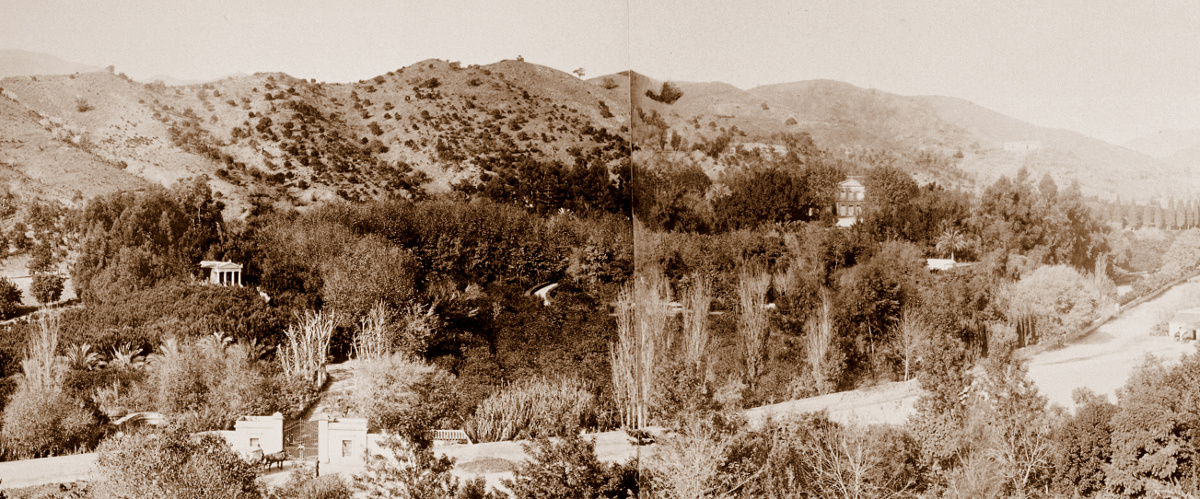Past and present
The origins of La Concepcion Estate can be traced back to the joining together of several smaller estates along the banks of the River Guadalmedina to the north of the city of Malaga. Used for agricultural purposes, they were home to cereal crops, olive and almond trees, vines, and, most notably, citrus trees. The garden was created by the Marquis and Marchioness of the House of Loring, Jorge Loring Oyarzabal and Amalia Heredia Livermore, both of whom were born to well-known businessmen who came to the city to make their fortunes. According to the jurist Rodriguez de Berlanga, the idea for the garden originally came to them after they had visited a series of palaces, villas, parks, estates, and botanical gardens during their honeymoon in Europe seven years earlier. To bring it to life, they enlisted the services of a French gardener, Jacinto Chamoussent, whose skilled selection and acclimatisation of exotic plants was subsequently rewarded with numerous prizes.
La Concepcion quickly became known throughout Europe, though not for its beautiful, exuberant garden but rather the magnificent collection of archaeological remains to be found at the Loring Museum, a Doric-style pavilion built in 1859 on a Roman mosaic originally discovered in the village of Cartama. For many years, the Lorings strove to restore all of the archaeological remains that they encountered, the highlight of their collection undoubtedly being the Lex Flavia Malacitana, a bronze piece displaying the Roman laws by which Malaga was governed in the year 80 AD and which now resides in the National Archaeology Museum; other pieces that once formed part of the collection can be found in the Provincial Museum, housed in Malaga's former Customs House.
In 1911, La Concepcion was sold to a husband and wife from Bilbao, Rafael Echevarria and Amalia Echevarrieta, who expanded the garden, adding new features such as the Nymph's Stream, the Palm Tree Avenue and the Viewpoint which overlooks the city. They also introduced numerous contemporary sculptures between the garden areas, adding to the archaeological exhibits that were already in place.
In 1943, La Concepcion was officially declared a Garden of Historical and Artistic Interest, and today it is also recognised as a Place of Cultural Interest.
After the death of the Basque couple, La Concepcion was taken over by Amalia's brother, Horacio Echevarrieta, who kept the estate in perfect condition until he died in 1963. This signalled the start of a period of decline for the estate, whose buildings and gardens were abandoned by the new heirs.
In 1990, the estate was purchased by Malaga City Council for 600 million pesetas (€3,606,073). Once the necessary infrastructure and adaptation work had been carried out, it was opened to the public in 1994 with two main aims: to conserve and embellish the Historical Garden itself and to turn the rest of the botanical garden into a space whose collections of plants could be used for scientific and educational purposes.
Acknowledged in 1943 as a “garden of historical and artistic interest”, this covers a total of 3.5 hectares. Its merit resides largely in its physical characteristics, the preservation of its original design, and the collection of subtropical fauna to which it is home. Located on the side of a hill, its landscaped layout comprises a series of waterfalls, streams, fountains, flights of steps, greenhouses, large trees and centuries-old palms, the latter constituting one of the finest collections in Europe.
Worthy of special note among the 3,000-plus species to be found here is the garden's enormous grove, which features a number of hundred-year-old specimens of ficuses (Ficus microcarpa and F. macrophylla), araucarias (Araucaria heterophylla and Araucaria bidwillii), casuarinas, magnolias, pines, cypresses and cedars. Other examples include cycas (Cycas revoluta and Cycas circinalis), giant birds of paradise (Strelitzia nicolai), bamboos (Phyllostachys nigra, Bambusa vulgaris, etc.), water lilies, and an unusual climbing vine (Wisteria sinensis) which covers an enormous 19th-century iron gazebo.
Surrounding the Historical Garden is the botanical garden, whose plants are arranged in scientific order. Near the entrance are collections of aquatic and prehistoric plants, a rockery highlighting biodiversity, a greenhouse of insectivorous plants, bromeliads and orchids, as well as collections of African plants and bamboos. To the north lies a route known as “Around the World in 80 Trees”, a further collection of palm trees to add to the one in the Historical Garden, and examples of different varieties of Malaga vines and olive trees in the section entitled “Plants of Our Region”. The upper fringe of the Historical Garden is home to the “Forest” and “Viewpoint” routes, both of which feature indigenous plants. The southernmost point of the garden houses two further collections, namely the cacti and succulents and the subtropical fruit trees, as well as the historical lemon grove.




